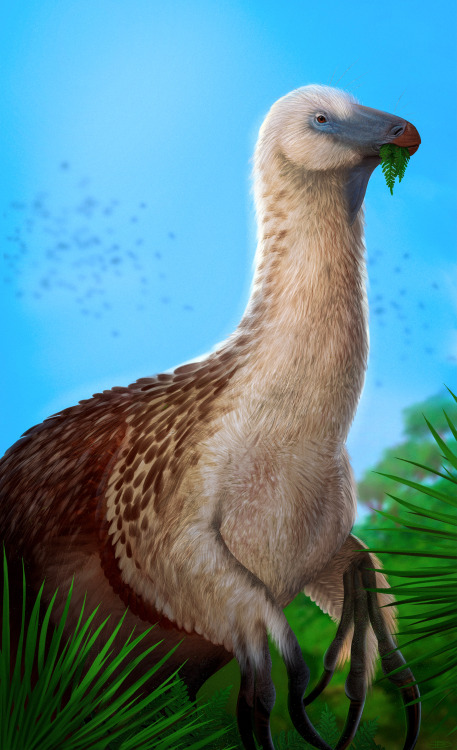#nothronychus

Just finished this dinosaur hybrid following an art prompt by Emily Stepp and suggestions by people on Twitter. Enjoy!

A concept of some sexually dimorphic Nothronychus. Colors were based on a lot of geese, bears, and a sloth. Seemed fitting. Also a laid-back scale guy for the casual office-bound paleontology nerd to relate to.
I probably got more detailed than I should have gotten, but I do like how it looks.
Nothronychus – Late Cretaceous (92-91 Ma)
This dinosaur is dumb. This dinosaur is SO dumb. It doesn’t sound like something that should be real, but it is. Its name is Nothronychus, and it’s a member of a group called therizinosaurs. They’re one of my favorite families of dinosaurs, but it took me so long to cover them because, honestly, I forgot something this bizarre existed.
This is a mid-sized member of its family from the western United States. That being said, it was 11 ft (3.4m) tall. Therizinosaurs were big. Nothronychus was an herbivore with a beak and blunt, leaf-shaped teeth. Its winglike arms may have been used to grasp tree branches, but we aren’t sure. The first Nothronychus bone to be found was part of the skull called the squamosal. This was originally thought to be a skull belonging to a primitive ceratopsian named Zuniceratops, but as more remains were discovered, we learned it was something much different, and much more recently understood.
Let’s talk about therizinosaurs as a group. They were some weird-ass dinosaurs. For starters, they’re herbivorous theropods. They’re part of the group called Coelurosaurs, which includes birds, dromaeosaurs, and tyrannosaurs. Like ceratopsians, they fist evolved in Asia and migrated to North America, probably across what we would today call the Bering Sea. Tens of millions of years later, our ancestors would reach North America using the same bridge. Therizinosaurs stood in that semi-upright, kangaroo-like stance we used to think all bipedal dinosaurs used. They were insulated by simple feathers, probably a mix of short, soft down and longer quills. Their most famous feature is their claws, which were used for… um, we don’t really know. Defense? Feeding? They had to be important somehow, considering how big they are.
Therizinosaur research has a long and convoluted history. Therizinosaurus, was originally described in 1954 as a turtle. Because the first name trumps all others, the sole species is still named Therizinosaurus cheloniformis (Turtle-shaped reaper lizard). Therizinosaurs were pretty much tucked away in a bin for the next 20-odd years until it was proposed that, hey, maybe we’re way off-base with this one and it’s actually a theropod. This idea was contested, as all new ideas in science are. Those of us who are less-inclined to believe in science point to this as evidence for science being dogmatic, but at the heart of every objection to a new theory is the simple question: “What’s your proof?” The proof was a little shaky back then, but it was suggested that therizinosaurs were theropods who were like big, prehistoric anteaters who used their claws to dig into insect mounds. It wasn’t until the decade was almost over that we finally found proof they were theropods, when a forelimb of Therizionsaurus was identified.
Despite that, we still kept finding therizinosaurs and thinking they were other things. Nanshiungosaurus was originally thought to be a sauropod, for example. Then, Segnosaurus was found, and interpreted as a fish-eater. A group of theropods was named after it, the segnosaurs. Although, then there was debate over whether or not they were actually sauropods, or maybe related to prosauropods. Their small heads and long necks were cited as evidence for that.
Thanks to computers and other big jumps in technology, paleontology advanced an awful lot in the 90s. We were suddenly able to set a lot of facts about extinct animals straight. We learned that just about every animal that would eventually be in this group was misidentified, and that ‘segnosaurs’ were actually just therizinosaurs, and that we had done kind of a bad job of recognizing them in the past. It wasn’t exactly expected that an entire oddball clade of dinosaurs was still out there waiting to be discovered. Paleontology can be fun like that.
Anyway, we now know they were big, weird herbivores with long claws for some reason. The two biggest, and honestly, most likely reasons, are for grasping branches and for defense. Nobody would want to fuck with an animal with giant scythe fingers, no matter how mild-mannered. We tend to think of herbivores as universally peaceful, but if you’ve ever seen that video of the jeep being chased by a giraffe, they’re that big for a reason. Hell, the most homicidal animals in Africa are hippos, because they’re just that fucking pissed all the time. If an herbivore has a weapon, it’s because it’s not afraid to use it.
Nothronychus is a relatively obscure animal. It appeared in a Discovery Channel special called When Dinosaurs Roamed America, where the main thing it did was slap a Dromaeosaurus and then die in a fire. Yeah. Pop culture representation for this group usually comes in the form of Therizinosaurus, which has shown up in a few places. It’s mentioned in Jurassic World as one of the animals whose DNA was used to create Indominus rex. It also shows up in ARK: Survival Evolved, where it has a short neck and a big head with no beak. The feathers aren’t exactly accurate either, but I don’t want to split too many hairs right now. It’s also apparently in the anime Dinosaur King, although I don’t know enough about that to elaborate.
Post link


